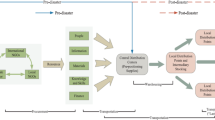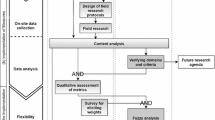Abstract
In this paper, a multitiered supply chain network equilibrium model is constructed, consisting of multiple humanitarian organizations, who seek to purchase services from multiple competing freight (logistic) service providers, for transportation of disaster relief supplies to multiple points of demand for distribution to victims. The freight service providers are faced with capacities associated with the volume of shipments that they can transport. We capture the behavior of the humanitarian organizations who individually minimize the total cost associated with payments for the freight transportation and their transaction costs. We also identify the profit-maximizing behavior of the freight service providers. The governing supply chain network equilibrium conditions are formulated as a variational inequality problem and conditions for existence given. We propose an algorithm for the computation of the equilibrium disaster relief item flows and Lagrange multipliers associated with the freight capacity constraints and provide conditions for convergence. The algorithm is then applied to several numerical examples comprising a case study focusing on an international healthcare crisis. In the case study, we explore the impacts of the addition of a freight service provider as well as that of a humanitarian organization on the profits of freight service providers and on the costs incurred by the humanitarian organizations. The theoretical and numerical results in this paper advance game theory frameworks for humanitarian operations and disaster relief, an area in which there is only a limited literature.
Presented at the 3rd International Conference on Dynamics of Disasters, July 5–9, 2017, Kalamata, Greece.
Access this chapter
Tax calculation will be finalised at checkout
Purchases are for personal use only
Similar content being viewed by others
References
Agence France-Presse: UN health agency declares killer Ebola epidenic a global disaster. Daily Nation, 8 Aug 2014. Available at: http://www.nation.co.ke/news/africa/UN-health-agency-declares-killer-Ebola-global-disaster/1066-2413066-11mwufwz/index.html
Ap, T.: Ebola crisis: WHO slammed by Harvard-convened over slow response. CNN, 23 Nov 2015
Balcik, B., Beamon, B.M., Smilowitz, K.: Last mile distribution in humanitarian relief. J. Intell. Transp. Syst. 12(2), 51–63 (2008)
BBC.com: Ebola: Map** the outbreak, 14 Jan 2016. Available at: http://www.bbc.com/news/world-africa-28755033
Fischer II, W.A., Hynes, N.A., Perl, T.M.: Protecting healthcare workers from Ebola: personal protective equipment is critical but not enough. Ann. Intern. Med. 161(10), 753–754 (2014)
Gabay, D., Moulin, H.: On the uniqueness and stability of Nash equilibria in noncooperative games. In: Bensoussan, A., Kleindorfer, P., Tapiero, C.S. (eds.) Applied Stochastic Control of Econometrics and Management Science, pp. 271–294. North-Holland, Amsterdam (1980)
Huang, M., Smilowitz, K., Balcik, B. Models for relief routing: equity, efficiency and efficacy. Transp. Res. E 48, 2–18 (2012)
Kinderlehrer, D., Stampacchia, G.: An Introduction to Variational Inequalities and Their Applications. Academic Press, New York (1980)
Korpelevich G.M.: The extragradient method for finding saddle points and other problems. Matekon 13, 35–49 (1977)
Miller-Hooks, E., Sorrel, G.: The maximal dynamic expected flows problem for emergency evacuation planning. Transp. Res. Rec. 2089, 26–34 (2008)
Muggy, L.: Quantifying and Mitigating Decentralized Decision Making in Humanitarian Logistics Systems. PhD Dissertation, Kansas State University, Manhattan (2015)
Muggy L., Heier Stamm, J.L.: Game theory applications in humanitarian operations: a review. J. Humanitarian Logistics Supply Chain Manag. 4(1), 4–23 (2014)
Na, H.S., Banerjee, A.: A disaster evacuation network model for transporting multiple priority evacuees. IIE Trans. 47(11), 1287–1299 (2015)
Nagurney, A.: Network Economics: A Variational Inequality Approach, 2nd and rev. ed. Kluwer Academic Publishers, Dordrecht (1999)
Nagurney, A.: Supply Chain Network Economics: Dynamics of Prices, Flows, and Profits. Edward Elgar Publishing. Cheltenham (2006)
Nagurney, A.: Freight service provision for disaster relief: a competitive network model with computations. In: Kotsireas, I.S., Nagurney, A., Pardalos, P.M. (eds.) Dynamics of Disasters: Key Concepts, Models, Algorithms, and Insights, pp 207–229. Springer International Publishing, Switzerland (2016)
Nagurney, A., Alvarez Flores, E., Soylu, C.: A generalized Nash equilibrium model for post-disaster humanitarian relief. Transp. Res. E 95, 1–18 (2016)
Nagurney, A., Daniele, P., Alvarez Flores, E., Caruso, A.: A variational equilibrium framework for humanitarian organizations in disaster relief: effective product delivery under competition for financial funds. In: Kotsireas, I.S., Nagurney, A., Pardalos, P.M. (eds.) Dynamics of Disasters: Algorithmic Approaches and Applications. Springer International Publishers, Switzerland (2018)
Nagurney, A., Dong, J., Zhang, D.: A supply chain network equilibrium model. Transp. Res. E 38, 281–303 (2002)
Nagurney, A., Masoumi, A.H., Yu, M.: An integrated disaster relief supply chain network model with time targets and demand uncertainty. In: Nijkamp, P., Rose, A., Kourtit, K. (eds.) Regional Science Matters: Studies Dedicated to Walter Isard, pp. 287–318. Springer International Publishing, Switzerland (2015)
Nagurney, A., Nagurney, L.S.: A mean-variance disaster relief supply chain network model for risk reduction with stochastic link costs, time targets, and demand uncertainty. In: Kotsireas, I.S., Nagurney, A., Pardalos, P.M. (eds.) Dynamics of Disasters: Key Concepts, Models, Algorithms, and Insights, pp. 75–99. Springer International Publishing, Switzerland (2016)
Nagurney, A., Saberi, S., Shivani, S., Floden, J.: Supply chain network competition in price and quality with multiple manufacturers and freight service providers. Transp. Res. E 77, 248–267 (2015)
Nagurney, A., Shukla, S.: Multifirm models of cybersecurity investment competition vs. cooperation and network vulnerability. Eur. J. Oper. Res. 260(2), 588–600 (2017)
Nagurney, A., Yu, M., Floden, J., Nagurney, L.S.: Supply chain network competition in time-sensitive markets. Transp. Res. E 70, 112–127 (2014)
Nash J.F.: Equilibrium points in n-person games. Proc. Natl. Acad. Sci. U. S. A. 36, 48–49 (1950)
Nash J.F.: The bargaining problem. Econometrica 18, 155–162 (1950)
Nash J.F.: Noncooperative games. Ann. Math. 54, 286–298 (1951)
Nash J.F.: Two person cooperative games. Econometrica 21, 128–140 (1953)
O’Byrne, R.: The Ebola outbreak and why logistics are struggling to cope. Logistics Bureau, 3 Nov 2014. Available at: http://www.logisticsbureau.com/the-ebola-outbreak-and-why-logistics-are-struggling/
Pedraza Martinez, A.J., Stapleton, O., Van Wassenhove, L.N.: Field vehicle fleet management in humanitarian operations: a case-based approach. J. Oper. Manag. 29(5), 404–421 (2011)
Regnier, E.: Public evacuation decisions and hurricane track uncertainty. Manag. Sci. 54(2), 16–28 (2008)
Saul, J.: Ship** industry modified clauses in contracts for Ebola risks. www.reuters.com, 16 Dec 2014. Available at: http://www.reuters.com/article/health-ebola-ship**-idUSL6N0U024W20141216
Sheffi, Y., Mahmassani, H., Powell, W.B.: A transportation network evacuation model. Transp. Res. A 16(3), 209–218 (1982)
The World Bank: Cost to export (US$ per container) (2016). http://data.worldbank.org/indicator/IC.EXP.COST.CD
Tseng, P.: On linear convergence of iterative methods for the variational inequality problem. J. Comput. Appl. Math. 60, 237–252 (1995)
United States Department of Commerce: Access costs everywhere (2016). http://acetool.commerce.gov/ship**
Van Wassenhove, L.N. Blackett memorial lecture. Humanitarian aid logistics: supply chain management in high gear. J. Oper. Res. Soc. 57(5), 475–489 (2006)
Vogiatzis, C., Pardalos, P.M.: Evacuation modeling and betweenness centrality. In: Kotsireas, I.S., Nagurney, A., Pardalos, P.M. (eds.) Dynamics of Disasters: Key Concepts, Models, Algorithms, and Insights, pp. 345–350. Springer International Publishing, Switzerland (2016)
Wilson, D.: CE: Inside an Ebola ET: A nurses’ report. Am. J. Nurs. 115(12), 28–38 (2015)
Wilson, D.: Ode to the humanitarian logistician: humanistic logistics through a nurse’s eye. In: Kotsireas, I.S., Nagurney, A., Pardalos, P.M. (eds.) Dynamics of Disasters: Key Concepts, Models, Algorithms, and Insights, pp. 361–369. Springer International Publishing, Switzerland (2016)
World Health Organization: Health worker Ebola infections in Guinea, Liberia and Sierra Leone: A preliminary report. Geneva, Switzerland, 21 May (2015)
Acknowledgements
The author acknowledges support by the Radcliffe Institute for Advanced Study at Harvard University during the summer of 2017, where she was a Summer Fellow. She also acknowledges support from the John F. Smith Memorial Fund at the University of Massachusetts Amherst.
The author thanks the co-organizers of the 3rd Dynamics of Disasters conference and the participants for engaging discussions. She also thanks the anonymous reviewer for helpful comments and suggestions on an earlier version of this paper.
Author information
Authors and Affiliations
Corresponding author
Editor information
Editors and Affiliations
Rights and permissions
Copyright information
© 2018 Springer Nature Switzerland AG
About this chapter
Cite this chapter
Nagurney, A. (2018). A Multitiered Supply Chain Network Equilibrium Model for Disaster Relief with Capacitated Freight Service Provision. In: Kotsireas, I., Nagurney, A., Pardalos, P. (eds) Dynamics of Disasters. DOD 2017. Springer Optimization and Its Applications, vol 140. Springer, Cham. https://doi.org/10.1007/978-3-319-97442-2_5
Download citation
DOI: https://doi.org/10.1007/978-3-319-97442-2_5
Published:
Publisher Name: Springer, Cham
Print ISBN: 978-3-319-97441-5
Online ISBN: 978-3-319-97442-2
eBook Packages: Mathematics and StatisticsMathematics and Statistics (R0)




